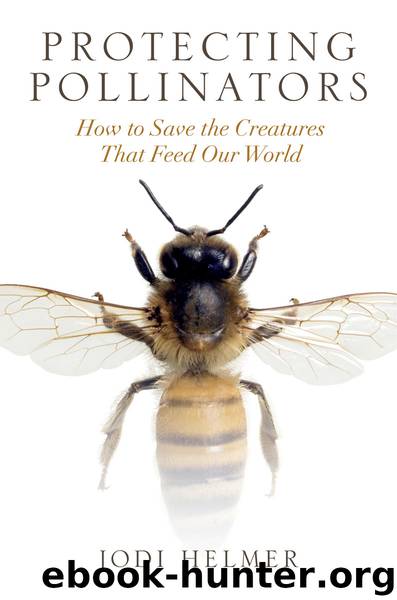Protecting Pollinators by Jodi Helmer

Author:Jodi Helmer
Language: eng
Format: epub
Publisher: Island Press
Published: 2019-05-03T04:00:00+00:00
Relocating for Survival
In addition to rising temperatures that result in advancing bloom times, LeBaron notes that climate shifts have changed migration patterns. Species living in the eastern United States normally migrate to Central America in the winter, but, as the temperatures in their overwintering grounds rise, the hummingbirds have started returning to the Gulf Coast of the United States earlier and spending more time in the area.
The ruby-throated hummingbird (Archilochus colubris) is arguably the prettiest of all hummingbirds. Adult males sport a black mask, green crown, and their namesake bright-red throats that look like jaunty mufflers around their necks. (Female ruby-throated hummingbirds have white, not red, throats.) The species is as fast as it is fancy, zipping between flowers at high speeds while maintaining the ability to shift its direction and speed of flight with amazing precision. Found in forests, hedgerows, and scrub across North America, these migratory birds have changed their travel patterns as a result of climate change.
Between 1880 and 1969, the first arrivals of ruby-throated hummingbirds in the spring advanced between 11.4 and 18.2 days (depending on latitude). The shifts in migration patterns were associated with warmer winter and spring temperatures in their North American breeding grounds. During warmer winters, the hummingbirds arrived later at high latitudes; their arrivals were later at both mid and high latitudes during warmer springs, leading researchers to suggest that the species was taking longer stopovers between their wintering grounds and their breeding grounds. LeBaron suspects that the hummingbirds might need the breaks to rebound from the stresses of migration, but the extended stops around Louisiana, Texas, Mississippi, Alabama, and Florida could put hummingbirds at risk because of competition with other birds in the area. The hummingbirds often arrive in their breeding range in poor condition.
During the fall migration, species living in the western United States started showing up along the East Coast, a phenomenon LeBaron believes could be a result of upticks in severe storms that displace the hummingbirds from their homes. The Audubon Society used citizen science data to develop a forecast of how climate changes over the next twenty, fifty, and eighty years could change the hummingbirds’ overwintering and breeding grounds. The projections raised concerns. “It’s a little scary in terms of looking at how the climate space available for some of these birds is potentially going to rapidly change or completely change,” LeBaron says.
The United Nations Food and Agriculture Organization notes that increases in global temperatures are having profound impacts on the ecosystem, and it remains unclear how pollinators will respond to climate change over the long term.
Bumblebees are among the creatures struggling to relocate to areas with cooler temperatures. In North America and Europe, bees at the edge of the northern range have failed to move farther north, while populations on the southern ends of their range are shifting to higher elevations, bringing more bumblebees together in less space. This contraction of their habitat will force the bees to compete for resources. On the southern ends of
Download
This site does not store any files on its server. We only index and link to content provided by other sites. Please contact the content providers to delete copyright contents if any and email us, we'll remove relevant links or contents immediately.
Sapiens: A Brief History of Humankind by Yuval Noah Harari(13052)
The Tidewater Tales by John Barth(12030)
Do No Harm Stories of Life, Death and Brain Surgery by Henry Marsh(6336)
Mastermind: How to Think Like Sherlock Holmes by Maria Konnikova(6235)
The Thirst by Nesbo Jo(5785)
Why We Sleep: Unlocking the Power of Sleep and Dreams by Matthew Walker(5641)
Sapiens by Yuval Noah Harari(4537)
Life 3.0: Being Human in the Age of Artificial Intelligence by Tegmark Max(4507)
The Longevity Diet by Valter Longo(4445)
The Rules Do Not Apply by Ariel Levy(3905)
The Immortal Life of Henrietta Lacks by Rebecca Skloot(3826)
The Body: A Guide for Occupants by Bill Bryson(3800)
Why We Sleep by Matthew Walker(3771)
Animal Frequency by Melissa Alvarez(3755)
Yoga Anatomy by Kaminoff Leslie(3701)
Barron's AP Biology by Goldberg M.S. Deborah T(3631)
The Hacking of the American Mind by Robert H. Lustig(3580)
All Creatures Great and Small by James Herriot(3515)
Yoga Anatomy by Leslie Kaminoff & Amy Matthews(3395)
